Optimization of Stripping Voltammetric Sensor by a Back Propagation Artificial Neural Network for the Accurate Determination of Pb(II) in the Presence of Cd(II)
Abstract
:1. Introduction
2. Experimental
2.1. Reagent and Apparatus
2.2. Preparation of Bi/Glassy Carbon Electrode
2.3. Pb(II) Detection by SWASV in the Presence of Cd(II)
2.4. Artificial Neural Network Modelling
2.5. Soil Samples Preparation
3. Result and Discussion
3.1. Optimization of Experimental Conditions
3.2. Electrochemical Characteristic of the Bi/GCE
3.3. Effects of Cd(II) on the SWASV Detection of Pb(II)
3.4. Proposed BP-ANN Model for the Detection of Pb(II)
3.4.1. Parameters Selection and Optimization
3.4.2. Establishment and Validation of the BP-ANN Model
3.5. Application to Real Sample Analysis
4. Conclusions
Supplementary Materials
Acknowledgements
Author Contributions
Conflicts of Interest
References
- Wang, Z.; Liu, E.; Zhao, X. Glassy carbon electrode modified by conductive polyaniline coating for determination of trace lead and cadmium ions in acetate buffer solution. Thin Solid Films 2011, 519, 5285–5289. [Google Scholar] [CrossRef]
- Xiao, L.; Xu, H.; Zhou, S.; Song, T.; Wang, H.; Li, S.; Gan, W.; Yuan, Q. Simultaneous detection of Cd(II) and Pb(II) by differential pulse anodic stripping voltammetry at a nitrogen-doped microporous carbon/Nafion/bismuth-film electrode. Electrochim. Acta 2014, 143, 143–151. [Google Scholar] [CrossRef]
- Wang, Z.; Liu, G.; Zhang, L.; Wang, H. Electrochemical detection of trace cadmium in soil using a Nafion/stannum film-modified molecular wire carbon paste electrodes. Ionics 2013, 19, 1687–1693. [Google Scholar] [CrossRef]
- Izadkhah, V.; Farmany, A.; Mortazavi, S.S. Voltammetric determination of copper in water samples using a Schiff base/carbon nanotube-modified carbon paste electrode. J. Ind. Eng. Chem. 2015, 21, 994–996. [Google Scholar] [CrossRef]
- Wang, J. Stripping Analysis: Principles, Instrumentation, and Applications; VCH Publishers: Weinheim, Germany, 1985. [Google Scholar]
- Chinowsky, T.M.; Saban, S.B.; Yee, S.S. Experimental data from a trace metal sensor combining surface plasmon resonance with anodic stripping voltammetry. Sens. Actuators B 1996, 35, 37–43. [Google Scholar] [CrossRef]
- Mafa, P.J.; Idris, A.O.; Mabuba, N.; Arotiba, A.O. Electrochemical co-detection of As(III), Hg(II) and Pb(II) on a bismuth modified exfoliated graphite electrode. Talanta 2016, 153, 99–106. [Google Scholar] [CrossRef] [PubMed]
- Lee, S.; Bong, S.; Ha, J.; Kwak, M.; Park, S.-K.; Piao, Y. Electrochemical deposition of bismuth on activated graphene-nafion composite for anodic stripping voltammetric determination of trace heavy metals. Sens. Actuators B 2015, 215, 62–69. [Google Scholar] [CrossRef]
- Chamjangali, M.A.; Kouhestani, H.; Masdarolomoor, F.; Daneshinejad, H. A voltammetric sensor based on the glassy carbon electrode modified with multi-walled carbon nanotube/poly (pyrocatechol violet)/bismuth film for determination of cadmium and lead as environmental pollutants. Sens. Actuators B 2015, 216, 384–393. [Google Scholar] [CrossRef]
- Chen, L.; Su, Z.H.; He, X.H.; Liu, Y.; Qin, C.; Zhou, Y.P.; Li, Z.; Wang, L.H.; Xie, Q.J.; Yao, S.Z. Square wave anodic stripping voltammetric determination of Cd and Pb ions at a Bi/Nafion/thiolated polyaniline/glassy carbon electrode. Electrochem. Commun. 2012, 15, 34–37. [Google Scholar] [CrossRef]
- Wang, J.; Lu, J.M.; Kirgöz, Ü.A.; Hocevar, S.B.; Ogorevc, B. Insights into the anodic stripping voltammetric behavior of bismuth film electrodes. Anal. Chim. Acta 2001, 434, 29–34. [Google Scholar] [CrossRef]
- Foster, C.W.; de Souza, A.P.; Metters, J.P.; Bertotti, M.; Banks, C.E. Metallic modified (bismuth, antimony, tin and combinations thereof) film carbon electrodes. Analyst 2015, 140, 7598–7612. [Google Scholar] [CrossRef] [PubMed]
- Laffont, L.; Hezard, T.; Gros, P.; Heimbürger, L.E.; Sonke, J.E.; Behra, P.; Evrard, D. Mercury(II) trace detection by a gold nanoparticle-modified glassy carbon electrode using square-wave anodic stripping voltammetry including a chloride desorption step. Talanta 2015, 141, 26–32. [Google Scholar] [CrossRef] [PubMed]
- Zhu, W.W.; Li, N.B.; Luo, H.Q. Simultaneous determination of chromium(III) and cadmium(II) by differential pulse anodic stripping voltammetry on a stannum film electrode. Talanta 2007, 72, 1733–1737. [Google Scholar] [CrossRef] [PubMed]
- Hutton, E.A.; Hocevar, S.B.; Ogorevc, B.; Smyth, M.R. Bismuth film electrode for simultaneous adsorptive stripping analysis of trace cobalt and nickel using constant current chronopotentiometric and voltammetric protocol. Electrochem. Commun. 2003, 5, 765–769. [Google Scholar] [CrossRef]
- Wang, J. Stripping analysis at bismuth electrodes: a review. Electroanalysis 2005, 17, 1341–1346. [Google Scholar] [CrossRef]
- Aragay, G.; Pons, J.; Merkoci, A. Recent trends in macro-, micro-, and nanomaterial-based tools and strategies for heavy-metal detection. Chem. Rev. 2011, 111, 3433–3458. [Google Scholar] [CrossRef] [PubMed]
- Choi, S.M.; Kim, D.M.; Jung, O.S.; Shim, Y.B. A disposable chronocoulometric sensor for heavy metal ions using a diaminoterthiophene-modified electrode doped with graphene oxide. Anal. Chim. Acta 2015, 892, 77–84. [Google Scholar] [CrossRef] [PubMed]
- Sosa, V.; Barceló, C.; Serrano, N.; Ariño, C.; Díaz-Cruz, J.M.; Esteban, M. Antimony film screen-printed carbon electrode for stripping analysis of Cd (II), Pb (II), and Cu (II) in natural samples. Anal. Chim. Acta 2015, 855, 34–40. [Google Scholar] [CrossRef] [PubMed]
- Zhao, G.; Wang, H.; Liu, G. Electrochemical Determination of Trace Cadmium in Soil by a Bismuth Film/Graphene-beta-cyclodextrin-Nafion Composite Modified Electrode. Int. J. Electrochem. Sci. 2016, 11, 1840–1851. [Google Scholar]
- Zhu, L.; Xu, L.; Huang, B.; Jia, N.; Tan, L.; Yao, S. Simultaneous determination of Cd (II) and Pb (II) using square wave anodic stripping voltammetry at a gold nanoparticle-graphene-cysteine composite modified bismuth film electrode. Electrochim. Acta 2014, 115, 471–477. [Google Scholar] [CrossRef]
- María-Hormigos, R.; Gismera, M.J.; Procopio, J.R.; Sevilla, M.T. Disposable screen-printed electrode modified with bismuth–PSS composites as high sensitive sensor for cadmium and lead determination. J. Electroanal. Chem. 2016, 767, 114–122. [Google Scholar] [CrossRef]
- Torrecilla, J.S.; Deetlefs, M.; Seddon, K.R.; Rodríguez, F. Estimation of ternary liquid-liquid equilibria for arene/alkane/ionic liquid mixtures using neural networks. Phys. Chem. Chem. Phys. 2008, 10, 5114–5120. [Google Scholar] [CrossRef] [PubMed]
- Bhatti, M.S.; Kapoor, D.; Kalia, R.K.; Reddy, A.S.; Thukral, A.K. RSM and ANN modeling for electrocoagulation of copper from simulated wastewater: Multi objective optimization using genetic algorithm approach. Desalination 2011, 274, 74–80. [Google Scholar] [CrossRef]
- Suah, F.B.M.; Ahmad, M.; Taib, M.N. Optimisation of the range of an optical fibre pH sensor using feed-forward artificial neural network. Sens. Actuators B 2003, 90, 175–181. [Google Scholar] [CrossRef]
- Ayodele, B.V.; Cheng, C.K. Modelling and optimization of syngas production from methane dry reforming over ceria-supported cobalt catalyst using artificial neural networks and Box–Behnken design. J. Ind. Eng. Chem. 2015, 32, 246–258. [Google Scholar] [CrossRef]
- Ariza-Avidad, M.; Cuellar, M.P.; Salinas-Castillo, A.; Pegalajar, M.C.; Vuković, J.; Capitán-Vallvey, L.F. Feasibility of the use of disposable optical tongue based on neural networks for heavy metal identification and determination. Anal. Chim. Acta 2013, 783, 56–64. [Google Scholar] [CrossRef] [PubMed]
- Bade, R.; Bijlsma, L.; Miller, T.H.; Barron, L.P.; Sancho, J.V.; Hernández, F. Suspect screening of large numbers of emerging contaminants in environmental waters using artificial neural networks for chromatographic retention time prediction and high resolution mass spectrometry data analysis. Sci. Total Environ. 2015, 538, 934–941. [Google Scholar] [CrossRef] [PubMed]
- Hush, D.R.; Horne, B.G. Progress in supervised neural networks. IEEE Signal Process. Mag. 1993, 10, 8–39. [Google Scholar] [CrossRef]
- Torrecilla, J.S.; Tortuero, C.; Cancilla, J.C.; Díaz-Rodríguez, P. Estimation with neural networks of the water content in imidazolium-based ionic liquids using their experimental density and viscosity values. Talanta 2013, 113, 93–98. [Google Scholar] [CrossRef] [PubMed]
- Torrecilla, J.S.; García, J.; Rojo, E.; Rodríguez, F. Estimation of toxicity of ionic liquids in leukemia rat cell line and acetylcholinesterase enzyme by principal component analysis, neural networks and multiple lineal regressions. J. Hazard. Mater. 2009, 164, 182–194. [Google Scholar] [CrossRef] [PubMed]
- Torrecilla, J.S.; Tortuero, C.; Cancilla, J.C.; Díaz-Rodríguez, P. Neural networks to estimate the water content of imidazolium-based ionic liquids using their refractive indices. Talanta 2013, 116, 122–126. [Google Scholar] [CrossRef] [PubMed]
- Liu, B.; Lu, L.; Wang, M.; Zi, Y. A Study of Nafion-Coated Bismuth-Film Electrode for the Determination of Zinc, Lead, and Cadmium in Blood Samples. Electroanalysis 2008, 20, 2363–2369. [Google Scholar] [CrossRef]
- Jiang, L.; Wang, Y.; Ding, J.; Lou, T.; Qin, W. An ionophore-Nafion modified bismuth electrode for the analysis of cadmium (II). Electrochem. Commun. 2010, 12, 202–205. [Google Scholar] [CrossRef]
- Scott, D.J.; Coveney, P.V.; Kilner, J.A.; Rossiny, J.C.H.; Alford, N.M.N. Prediction of the functional properties of ceramic materials from composition using artificial neural networks. J. Eur. Ceram. Soc. 2007, 27, 4425–4435. [Google Scholar] [CrossRef]
- Guadix, A.; Zapata, J.E.; Almecija, M.C.; Guadix, E.M. Predicting the flux decline in milk cross-flow ceramic ultrafiltration by artificial neural networks. Desalination 2010, 250, 1118–1120. [Google Scholar] [CrossRef]
- Cheok, C.Y.; Chin, N.L.; Yusof, Y.A.; Talib, R.A.; Law, C.L. Optimization of total phenolic content extracted from Garcinia mangostana Linn. hull using response surface methodology versus artificial neural network. Ind. Crops Prod. 2012, 40, 247–253. [Google Scholar] [CrossRef]
- Sadeghi, B.H.M.; Mater, J. A BP-neural network predictor model for plastic injection molding process. Process. Technol. 2000, 103, 411–416. [Google Scholar] [CrossRef]
- Maran, J.P.; Sivakumar, V.; Thirugnanasambandham, K.; Sridhar, R. Artificial neural network and response surface methodology modeling in mass transfer parameters predictions during osmotic dehydration of Carica papaya L. Alexandria Eng. J. 2013, 52, 507–516. [Google Scholar] [CrossRef]

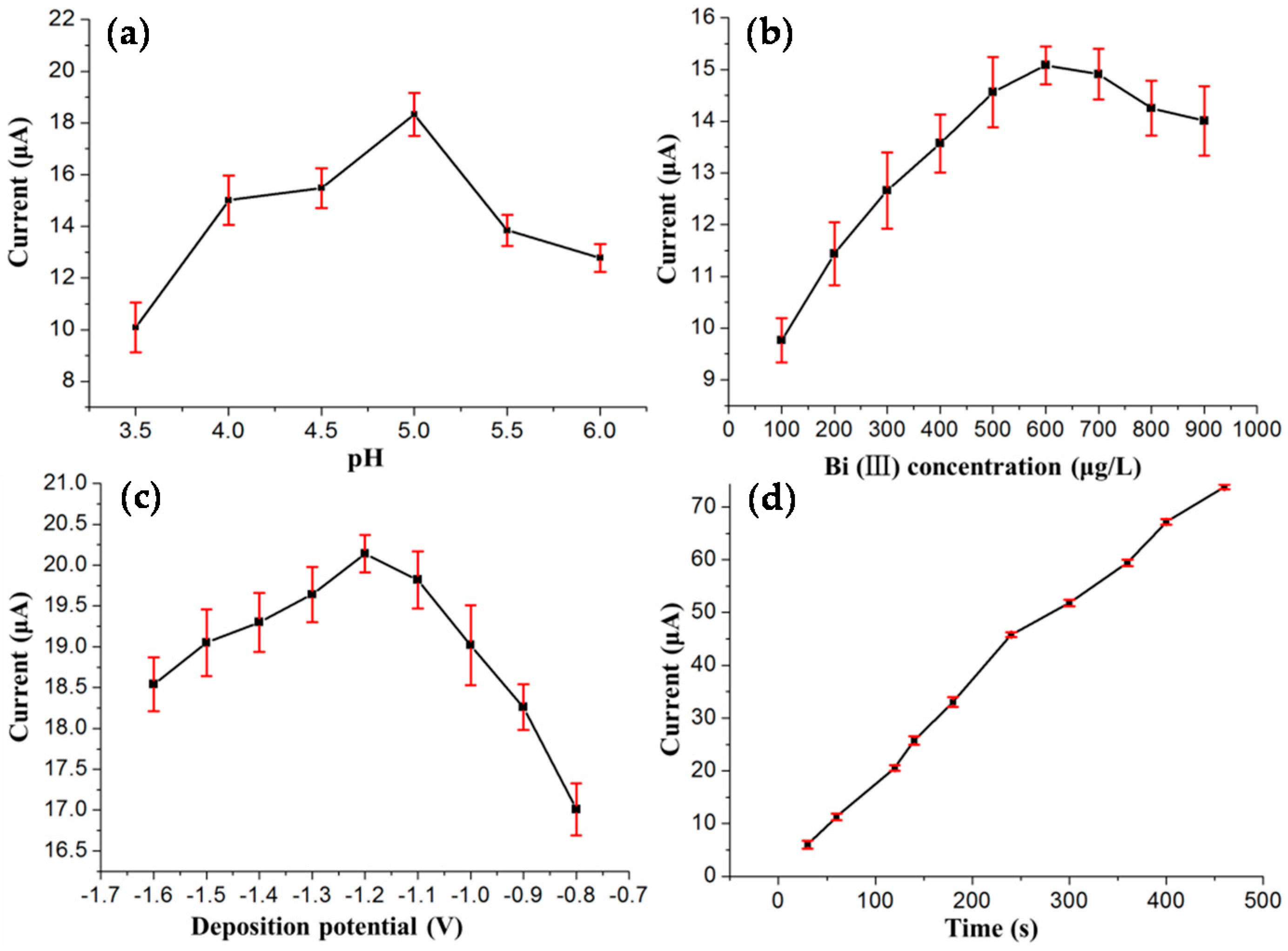
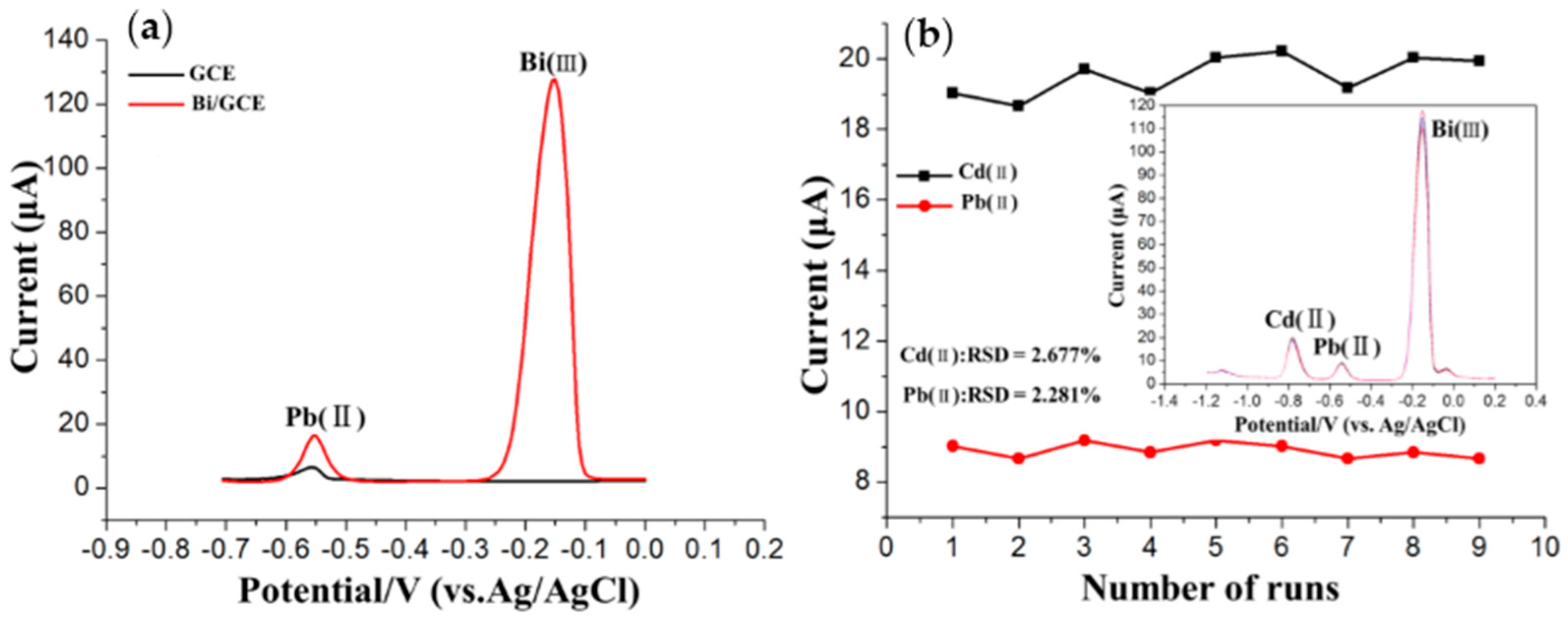
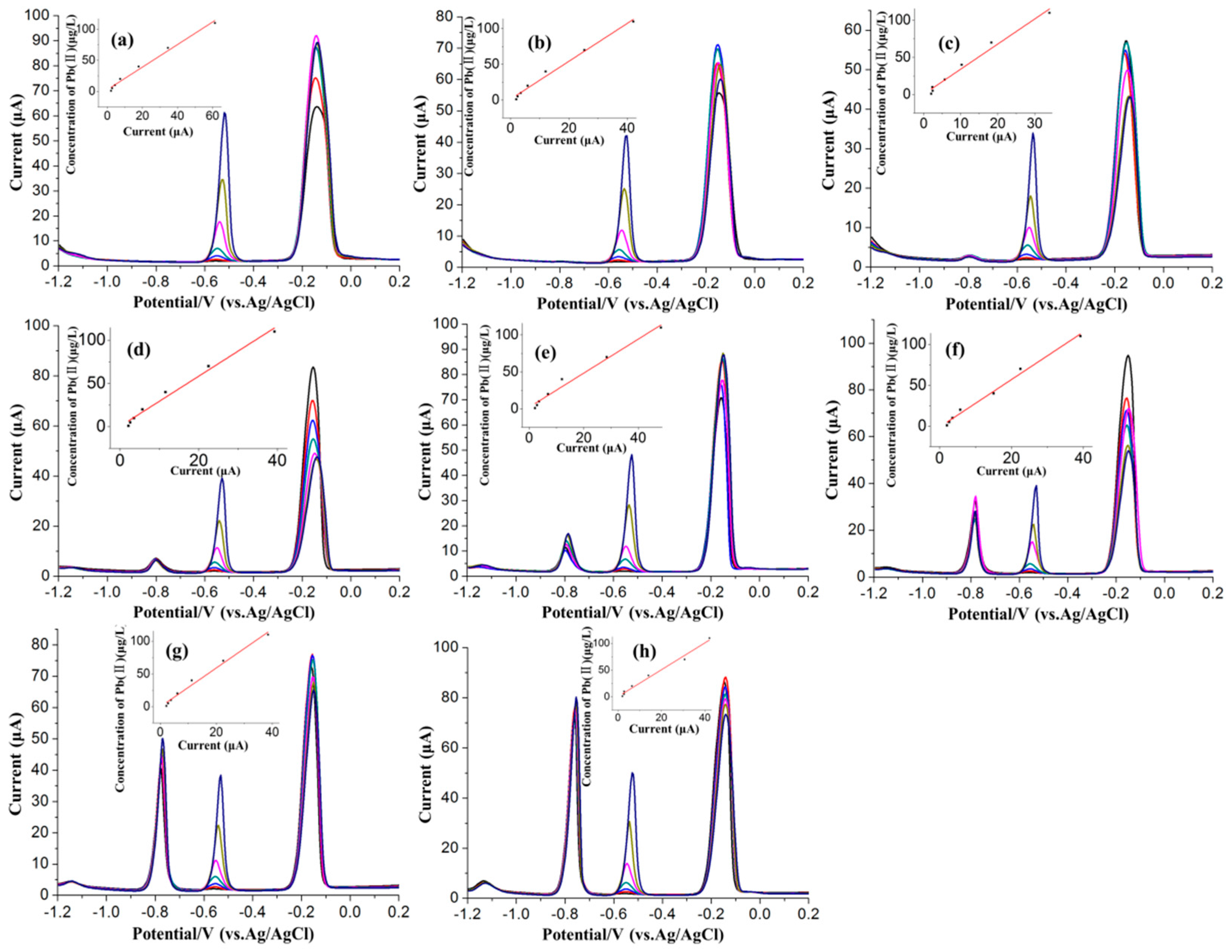
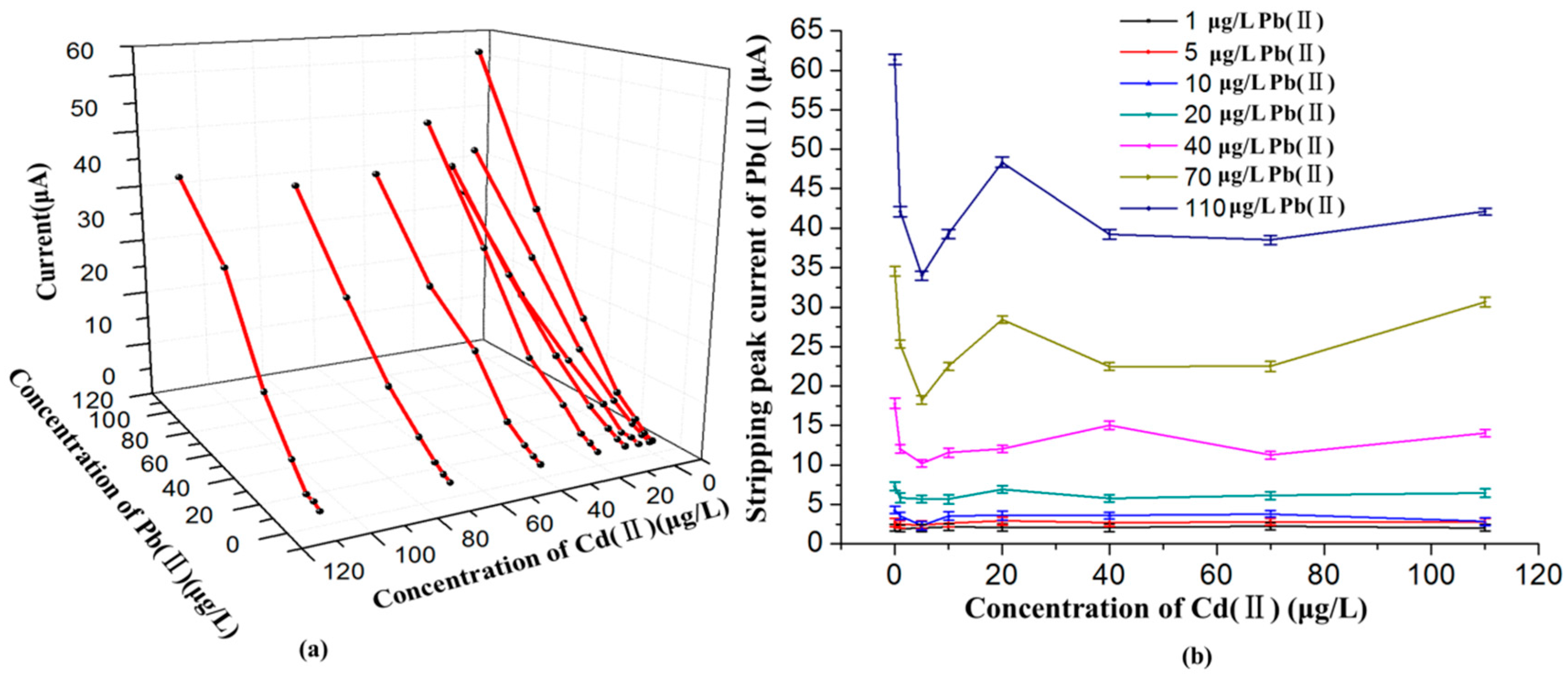
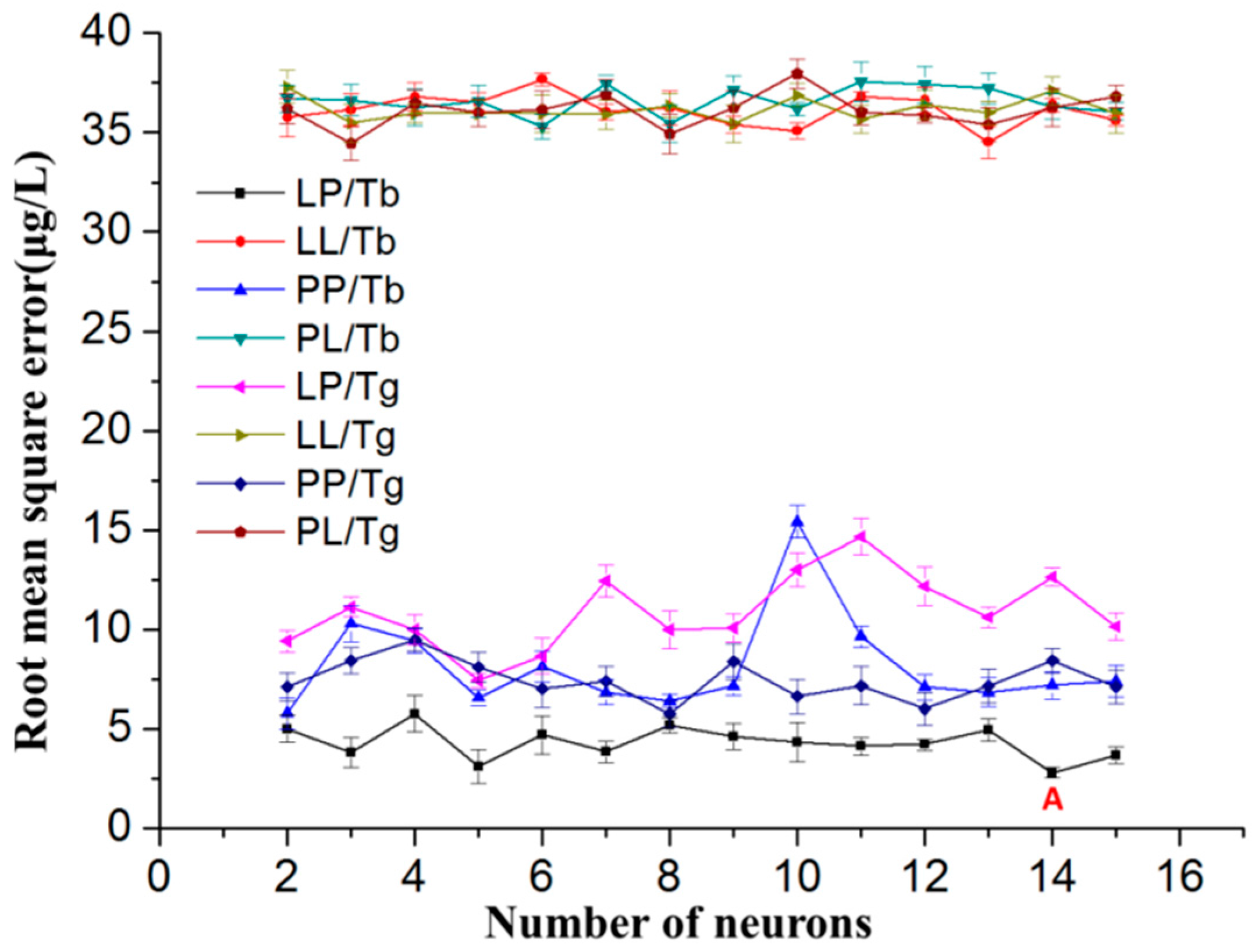
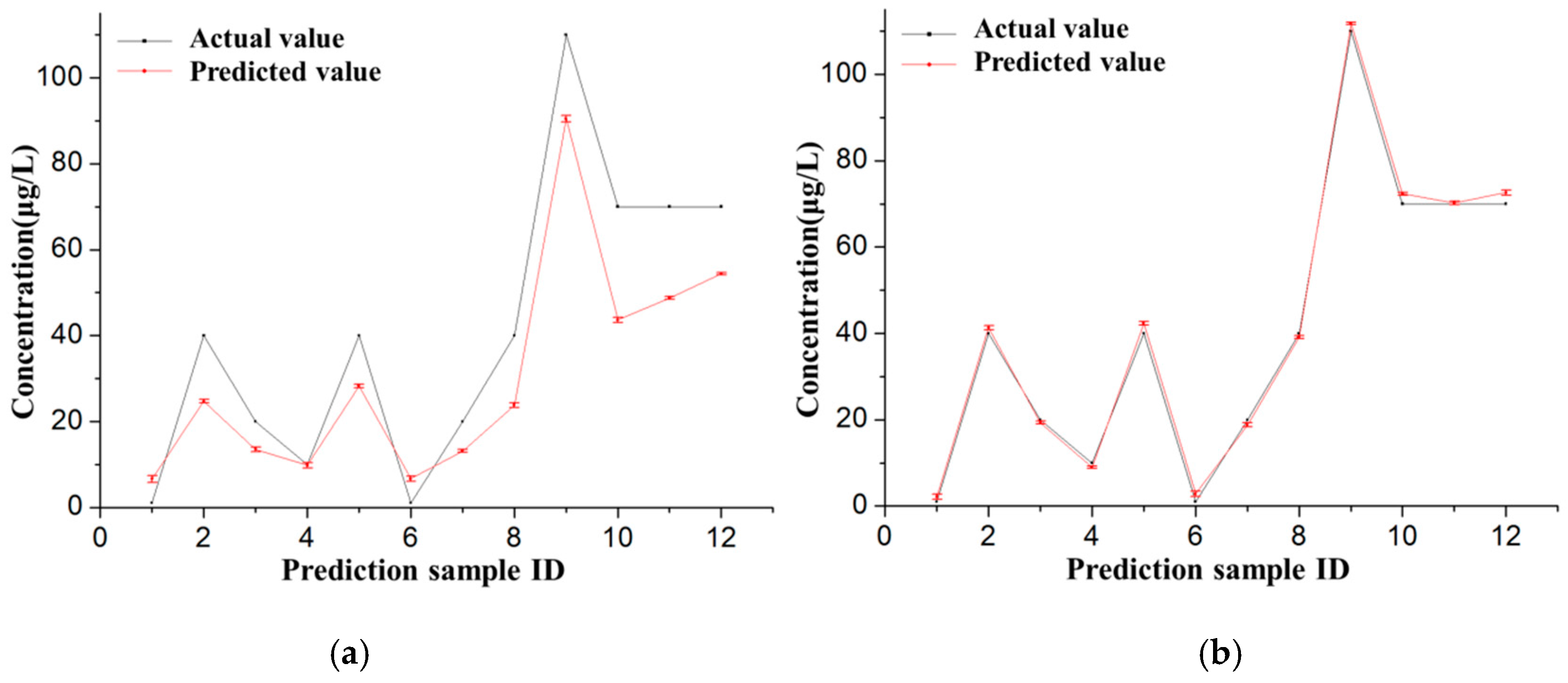
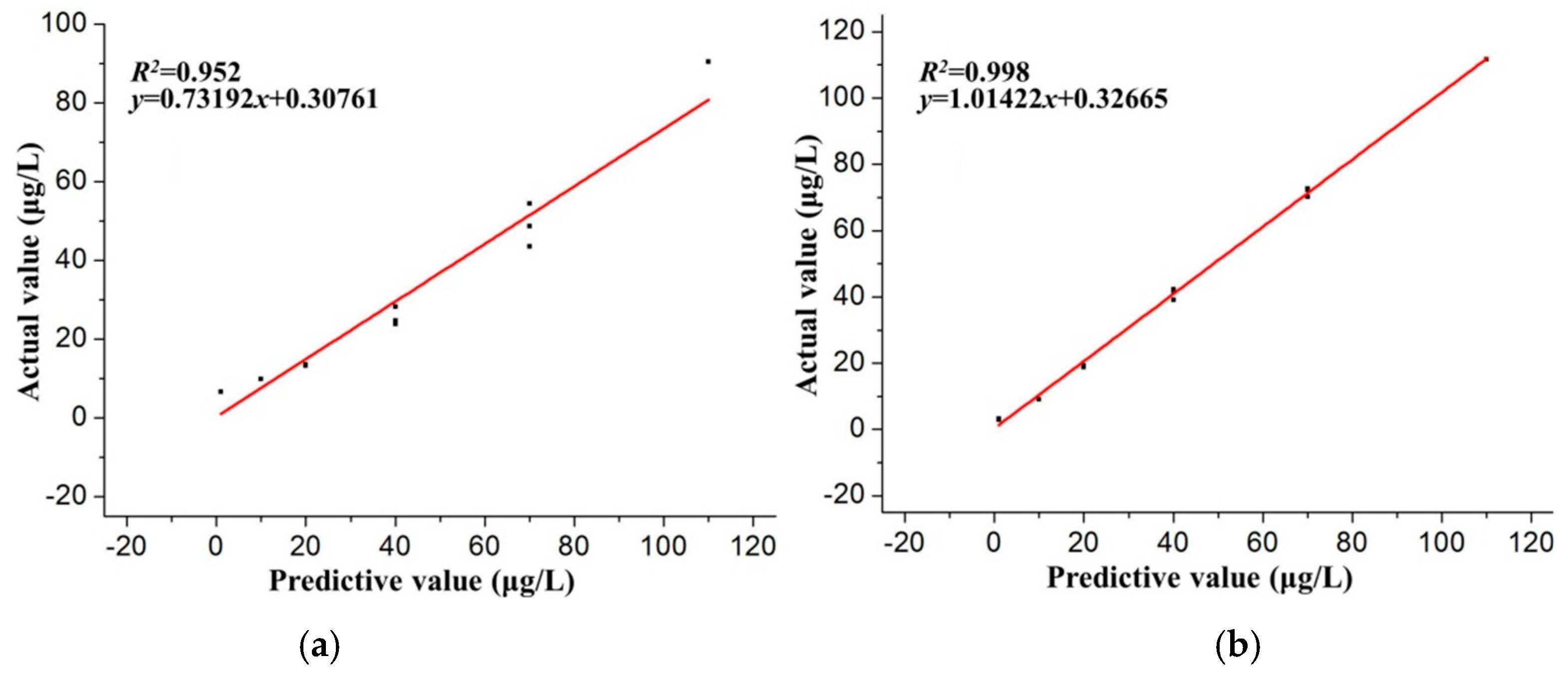
| Concentration of Cd(II) (μg/L) | Calibration Linear Equation of Pb(II) | Adjust R-Square | Prob > F | Confidence Level (%) | |||
|---|---|---|---|---|---|---|---|
| Slope | Intercept | ||||||
| Value | Standard Error | Value | Standard Error | ||||
| 0 | 1.81136 | 0.08873 | 2.8841 | 2.45566 | 0.98577 | 5.22 × 10−6 | 95 |
| 1 | 2.6529 | 0.12407 | 1.1957 | 2.39892 | 0.98702 | 4.15 × 10−6 | 95 |
| 5 | 3.38167 | 0.20087 | 0.3585 | 3.07612 | 0.9792 | 1.35 × 10−5 | 95 |
| 10 | 2.8954 | 0.14708 | 0.4616 | 2.63022 | 0.98471 | 6.25 × 10−6 | 95 |
| 20 | 2.30259 | 0.13952 | 2.2375 | 3.05889 | 0.97837 | 1.49 × 10−5 | 95 |
| 40 | 2.90499 | 0.12191 | −1.1498 | 2.22284 | 0.98953 | 2.42 × 10−6 | 95 |
| 70 | 2.97084 | 0.1474 | −0.4567 | 2.60129 | 0.98541 | 5.56 × 10−6 | 95 |
| 110 | 2.5196 | 0.13286 | 0.2467 | 2.73749 | 0.98355 | 7.51 × 10−6 | 95 |
| Concentration of Cd(II) (μg/L) | Calibration Linear Equation of Pb(II) | Mean Absolute Error (μg/L) | Average Relative Error (%) |
|---|---|---|---|
| 0 | Y = 1.81136 X + 2.88406 | 45.55 | 41.41 |
| 1 | Y = 2.6529 X + 1.19574 | 18.63 | 16.94 |
| 5 | Y = 3.38167 X + 0.35853 | 5.30 | 4.82 |
| 10 | Y = 2.8954 X + 0.46164 | 11.12 | 10.11 |
| 20 | Y = 2.30259 X + 2.23745 | 29.5 | 26.82 |
| 40 | Y = 2.90499 X − 1.14984 | 12.41 | 11.28 |
| 70 | Y = 2.97084 X − 0.45666 | 9.48 | 8.62 |
| 110 | Y = 2.5196 X + 0.24673 | 24.11 | 21.92 |
| Data Set | MAE (μg/L) | RMSE (μg/L) | ARE (%) | R2 |
|---|---|---|---|---|
| Training Dataset | 0.89 | 1.31 | 11.24 | 0.999 |
| Testing Dataset | 1.52 | 1.69 | 28.88 | 0.998 |
| Prediction Method | MAE (μg/L) | RMSE (μg/L) | ARE (%) | R2 |
|---|---|---|---|---|
| Direct Calibration | 12.56 | 14.6 | 117.61 | 0.952 |
| Artificial Neural Network | 1.52 | 1.69 | 28.88 | 0.998 |
| Sample No. | Added (μg/L) | Found (μg/L) a | RSD | Recovery (%) |
|---|---|---|---|---|
| 1 | - | 3.73 | 3.13 | - |
| 4 | 7.59 | 2.18 | 96.5 | |
| 8 | 11.62 | 2.49 | 98.63 | |
| 2 | - | 4.55 | 3.32 | - |
| 15 | 19.27 | 2.51 | 98.13 | |
| 30 | 34.21 | 1.23 | 98.87 | |
| 3 | - | 6.79 | 1.57 | - |
| 45 | 51.18 | 3.41 | 98.64 | |
| 90 | 96.54 | 1.22 | 99.72 |
© 2016 by the authors; licensee MDPI, Basel, Switzerland. This article is an open access article distributed under the terms and conditions of the Creative Commons Attribution (CC-BY) license (http://creativecommons.org/licenses/by/4.0/).
Share and Cite
Zhao, G.; Wang, H.; Liu, G.; Wang, Z. Optimization of Stripping Voltammetric Sensor by a Back Propagation Artificial Neural Network for the Accurate Determination of Pb(II) in the Presence of Cd(II). Sensors 2016, 16, 1540. https://doi.org/10.3390/s16091540
Zhao G, Wang H, Liu G, Wang Z. Optimization of Stripping Voltammetric Sensor by a Back Propagation Artificial Neural Network for the Accurate Determination of Pb(II) in the Presence of Cd(II). Sensors. 2016; 16(9):1540. https://doi.org/10.3390/s16091540
Chicago/Turabian StyleZhao, Guo, Hui Wang, Gang Liu, and Zhiqiang Wang. 2016. "Optimization of Stripping Voltammetric Sensor by a Back Propagation Artificial Neural Network for the Accurate Determination of Pb(II) in the Presence of Cd(II)" Sensors 16, no. 9: 1540. https://doi.org/10.3390/s16091540
APA StyleZhao, G., Wang, H., Liu, G., & Wang, Z. (2016). Optimization of Stripping Voltammetric Sensor by a Back Propagation Artificial Neural Network for the Accurate Determination of Pb(II) in the Presence of Cd(II). Sensors, 16(9), 1540. https://doi.org/10.3390/s16091540






